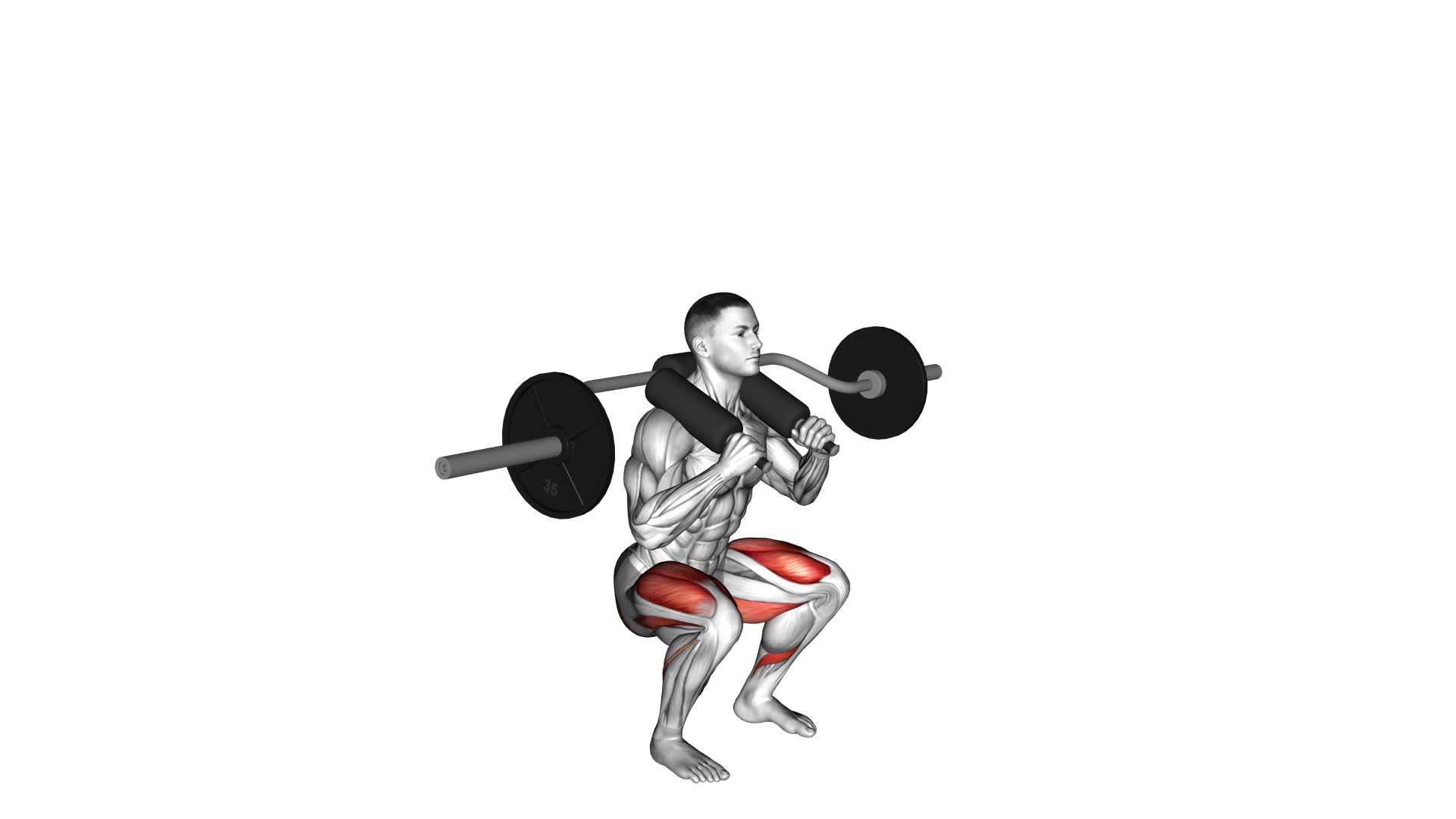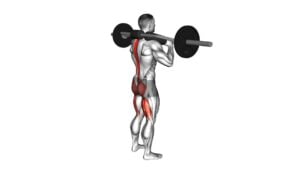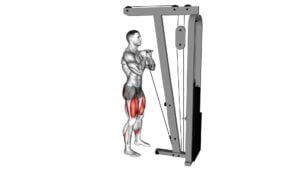Safety Bar Front Squat – Video Exercise Guide & Tips

Looking to take your squat game to the next level? The safety bar front squat is a powerful exercise that can help you build strength and stability in your lower body.
Watch This Exercise Video
In this video exercise guide, we'll walk you through proper form and technique, as well as common mistakes to avoid.
Whether you're a beginner or an advanced lifter, we've got tips and variations to help you progress and maximize your gains.
Get ready to squat like a pro!
Key Takeaways
- Safety bar front squats offer enhanced stability and reduced strain on shoulders and wrists.
- They improve posture and reduce stress on the lower back.
- Safety bar front squats activate core muscles more effectively.
- They accommodate different fitness levels and body types and can be adjusted to vary intensity.
Benefits of the Safety Bar Front Squat
Experience enhanced stability and reduced strain on your shoulders and wrists with the Safety Bar Front Squat. This variation of the front squat offers numerous benefits for your workout routine.
One of the main advantages is improved posture and reduced stress on your lower back. By using the safety bar, you can maintain an upright position throughout the exercise, preventing excessive forward lean that can strain your back.
Another benefit of the Safety Bar Front Squat is the increased activation of your core muscles. The position of the bar forces you to engage your abdominal muscles to maintain proper form and stability. This not only strengthens your core but also improves your overall balance and coordination.
Furthermore, the Safety Bar Front Squat allows for modifications to accommodate different fitness levels and body types. By adjusting the height of the safety bar, you can vary the intensity of the exercise. Beginners can start with a higher bar position to reduce the load on their legs, while more advanced individuals can lower the bar for a greater challenge.
Proper Form and Technique
To perform the Safety Bar Front Squat with proper form and technique, ensure that your grip on the safety bar is secure. This will help you maintain control and stability throughout the exercise.
Here are some key tips to keep in mind:
- Common cues:
- Keep your chest up and maintain a neutral spine throughout the movement. This will help prevent any excessive rounding or arching of the back.
- Engage your core muscles by bracing them as if you were preparing to be punched in the stomach. This will help stabilize your torso and protect your lower back.
- Initiate the squat by bending at your hips and knees simultaneously. Focus on pushing your hips back while keeping your knees in line with your toes.
- Common misconceptions:
- One common mistake is letting your knees cave inwards. To avoid this, actively push your knees outwards as you squat down.
- Another misconception is to rely heavily on the safety bar for support. While the safety bar provides stability, it's important to engage your core and lower body muscles to perform the movement correctly.
Common Mistakes to Avoid
To avoid common mistakes when performing the Safety Bar Front Squat, always remember to consistently maintain proper form and technique.
One of the most common mistakes is failing to keep your core engaged throughout the entire movement. This not only compromises your stability but also puts unnecessary strain on your lower back.
Another mistake to avoid is allowing your knees to cave inwards during the squat. This can lead to knee pain and potential injuries. To prevent this, focus on pushing your knees outwards as you lower yourself down.
Additionally, it's important to maintain an upright torso throughout the exercise. Leaning too far forward can cause excessive stress on your back and decrease the effectiveness of the squat.
Lastly, be mindful of the depth of your squat. Going too low can put excessive strain on your knees, while not going low enough limits the benefits of the exercise. Aim to lower yourself until your thighs are parallel to the ground.
Safety Bar Front Squat Variations
To explore different ways to challenge and progress your workout, there are several variations of the Safety Bar Front Squat that you can incorporate into your training routine. These modifications won't only keep your workouts interesting but also target different muscles and improve your overall strength and stability.
Here are three variations of the Safety Bar Front Squat that you can try:
- Tempo Squats: Slow down the movement by lowering yourself into the squat position for a count of three or four, then pause for a second at the bottom before explosively driving back up. This variation increases time under tension, making your muscles work harder and promoting muscle growth.
- Elevated Heel Squats: Place weight plates or a small platform under your heels to elevate them slightly. This modification helps to improve ankle mobility and allows for a deeper squat while maintaining proper form.
- Single-Leg Squats: Stand on one leg and hold the safety bar in front of you. Lower yourself down into a squat position while keeping your balance. This variation challenges your stability and works your leg muscles in a different way.
When performing these variations, it's important to use the best equipment for the Safety Bar Front Squat. A high-quality safety bar with secure padding and adjustable height is essential to ensure proper form and minimize the risk of injury.
Incorporating these modifications into your training routine will help you constantly challenge yourself and achieve better results.
Tips for Progression and Advanced Lifters
To maximize your progress and take your Safety Bar Front Squat to the next level, focus on incorporating advanced techniques and strategies into your training routine.
These progression tips and advanced techniques will help you challenge your muscles in new ways and continue to make gains in strength and performance.
One effective progression tip is to gradually increase the weight you're lifting. Start by adding small increments of weight to your Safety Bar Front Squat, and gradually increase the load as you become more comfortable and confident with the movement. This will help you build strength and continue to challenge your muscles.
Another advanced technique to consider is incorporating tempo training into your routine. This involves controlling the speed at which you lower and raise the weight during the squat. By slowing down the eccentric (lowering) phase of the movement, you can increase time under tension and stimulate more muscle growth.
Additionally, you can experiment with different squat variations to further challenge your muscles. For example, you can try pausing at the bottom of the squat or performing a single-leg Safety Bar Front Squat. These variations can help you develop stability, improve balance, and target specific muscle groups.
Remember to always prioritize proper form and technique, especially when incorporating advanced techniques. It's important to listen to your body and progress at a pace that's comfortable for you.
Frequently Asked Questions
What Kind of Safety Features Does a Safety Bar Front Squat Provide?
A safety bar front squat provides numerous benefits and safety features.
By using a safety bar, you can maintain proper form and reduce the risk of injury while performing front squats.
The bar is designed to sit on your shoulders, allowing you to keep your torso upright and engage your core effectively.
This equipment also provides stability and support, making it suitable for beginners or those with limited mobility.
Incorporating a safety bar into your workout routine can enhance your overall squatting experience.
Can the Safety Bar Front Squat Be Modified for Individuals With Limited Mobility or Injuries?
If you have limited mobility or injuries, there are modified variations of the safety bar front squat that can be done. These modifications allow you to still engage your lower body muscles while reducing strain on the injured area.
Injury modifications may include adjusting the range of motion, using lighter weights, or utilizing additional support such as a stability ball or resistance bands.
It's important to consult with a fitness professional or physical therapist to ensure proper form and safety.
How Does the Safety Bar Front Squat Compare to Other Variations of the Front Squat?
The safety bar front squat is a variation of the front squat that offers unique benefits compared to the traditional front squat.
It places less stress on your wrists and shoulders, making it a great option for those with limited mobility or injuries in those areas.
The safety bar also helps to maintain a more upright torso position, which can target your quads and glutes more effectively.
Are There Any Specific Warm-Up Exercises or Stretches Recommended Before Performing the Safety Bar Front Squat?
Before performing the safety bar front squat, it's important to warm up your muscles and perform specific stretches to prevent injuries and improve mobility.
Some recommended warm-up exercises include bodyweight squats, lunges, and hip openers.
Stretches such as the hip flexor stretch and calf stretch can also be beneficial.
What Are Some Tips for Incorporating the Safety Bar Front Squat Into a Well-Rounded Workout Routine?
To incorporate the safety bar front squat into a well-rounded workout routine, start by understanding its benefits and muscle groups targeted.
This exercise helps develop lower body strength and stability, targeting the quadriceps, glutes, and core.
Begin with 3-4 sets of 8-12 reps, gradually increasing weight and reps as you progress.
Remember to maintain proper form, keeping your back straight and core engaged.
Incorporating this squat variation will enhance your overall leg strength and contribute to a balanced workout routine.
Conclusion
In conclusion, the safety bar front squat is a highly beneficial exercise for building strength and stability in the lower body. By maintaining proper form and technique, you can maximize the effectiveness of this exercise and avoid common mistakes.
Additionally, there are variations of the safety bar front squat that can be incorporated for added challenge and progression. Whether you're a beginner or an advanced lifter, following these tips will help you safely and efficiently perform the safety bar front squat.

Author
Years ago, the spark of my life’s passion ignited in my mind the moment I stepped into the local gym for the first time. The inaugural bead of perspiration, the initial endeavor, the very first surge of endorphins, and a sense of pride that washed over me post-workout marked the beginning of my deep-seated interest in strength sports, fitness, and sports nutrition. This very curiosity blossomed rapidly into a profound fascination, propelling me to earn a Master’s degree in Physical Education from the Academy of Physical Education in Krakow, followed by a Sports Manager diploma from the Jagiellonian University. My journey of growth led me to gain more specialized qualifications, such as being a certified personal trainer with a focus on sports dietetics, a lifeguard, and an instructor for wellness and corrective gymnastics. Theoretical knowledge paired seamlessly with practical experience, reinforcing my belief that the transformation of individuals under my guidance was also a reflection of my personal growth. This belief holds true even today. Each day, I strive to push the boundaries and explore new realms. These realms gently elevate me to greater heights. The unique combination of passion for my field and the continuous quest for growth fuels my drive to break new ground.







